Bromine Crossover in Operando Analysis of Proton Exchange Membranes in Hydrogen−Bromate Flow Batteries
Abstract
:1. Introduction
- Loss of active materials in chemical reactions;
- Cross-contamination of electrolytes, which necessitates regular corrections of the electrolytes’ compositions;
- Corrosion and contamination of the electrode catalysts by species penetrating from the opposite compartment.
2. Materials and Methods’
2.1. Flow Cell Design and Materials
2.2. Methods
2.2.1. Electrochemical Measurements
2.2.2. Detection of Bromine-Containing Species in the Effluent from the Anode Compartment
Detection of Bromine-Containing Species by pH Measurements
Detection of the Bromine-Containing Species by Electrochemical Method
2.2.3. Main Chemical Transformations
3. Results and Discussion
3.1. Crossover through Membranes of Various Types and Thicknesses
3.2. Testing of a Hydrogen−Bromate Flow Battery
4. Conclusions
Author Contributions
Funding
Institutional Review Board Statement
Informed Consent Statement
Data Availability Statement
Conflicts of Interest
References
- Desa, U.N. Transforming Our World: The 2030 Agenda for Sustainable Development. Available online: https://sdgs.un.org/2030agenda (accessed on 19 July 2022).
- Al-Dousari, A.; Al-Nassar, W.; Al-Hemoud, A.; Alsaleh, A.; Ramadan, A.; Al-Dousari, N.; Ahmed, M. Solar and wind energy: Challenges and solutions in desert regions. Energy 2019, 176, 184–194. [Google Scholar] [CrossRef]
- Sun, C.; Negro, E.; Vezzù, K.; Pagot, G.; Cavinato, G.; Nale, A.; Bang, Y.H.; Di Noto, V. Hybrid inorganic-organic proton-conducting membranes based on SPEEK doped with WO3 nanoparticles for application in vanadium redox flow batteries. Electrochim. Acta 2019, 309, 311–325. [Google Scholar] [CrossRef]
- Vorotyntsev, M.A.; Antipov, A.E.; Konev, D.V. Bromate anion reduction: Novel autocatalytic (EC′′) mechanism of electrochemical processes. Its implication for redox flow batteries of high energy and power densities. Pure Appl. Chem. 2017, 89, 1429–1448. [Google Scholar] [CrossRef]
- Modestov, A.D.; Konev, D.V.; Antipov, A.E.; Vorotyntsev, M.A. Hydrogen-bromate flow battery: Can one reach both high bromate utilization and specific power? J. Solid State Electrochem. 2019, 23, 3075–3088. [Google Scholar] [CrossRef]
- Modestov, A.D.; Konev, D.V.; Tripachev, O.V.; Antipov, A.E.; Tolmachev, Y.V.; Vorotyntsev, M.A. A Hydrogen-Bromate Flow Battery for Air-Deficient Environments. Energy Technol. 2018, 6, 242–245. [Google Scholar] [CrossRef]
- Vorotyntsev, M.A.; Antipov, A.E. Bromate electroreduction in acidic solution inside rectangular channel under flow-through porous electrode conditions. Electrochim. Acta 2019, 323, 134799. [Google Scholar] [CrossRef]
- Petrov, M.M.; Konev, D.V.; Kuznetsov, V.V.; Antipov, A.E.; Glazkov, A.T.; Vorotyntsev, M.A. Electrochemically driven evolution of Br−containing aqueous solution composition. J. Electroanal. Chem. 2019, 836, 125–133. [Google Scholar] [CrossRef]
- Vorotyntsev, M.A.; Antipov, A.E. Bromate electroreduction from acidic solution at spherical microelectrode under steady-state conditions: Theory for the redox-mediator autocatalytic (EC′′) mechanism. Electrochim. Acta 2017, 258, 544–553. [Google Scholar] [CrossRef]
- Konev, D.V.; Vorotyntsev, M.A.; Loktionov, P.A.; Kartashova, N.V.; Antipov, A.E.; Modestov, A.D.; Glazkov, A.T.; Abunaeva, L.Z. Luggin Capillary Device for Membrane-Electrode Assemblies of Electrochemical Flow Reactors and Power Sources. RU Patent 198 483, 13 July 2020. [Google Scholar]
- Perry, M.L.; Saraidaridis, J.D.; Darling, R.M. Crossover mitigation strategies for redox-flow batteries. Curr. Opin. Electrochem. 2020, 21, 311–318. [Google Scholar] [CrossRef]
- Yao, Y.; Lei, J.; Shi, Y.; Ai, F.; Lu, Y.-C. Assessment methods and performance metrics for redox flow batteries. Nat. Energy 2021, 6, 582–588. [Google Scholar] [CrossRef]
- Rodby, K.E.; Perry, M.L.; Brushett, F.R. Assessing capacity loss remediation methods for asymmetric redox flow battery chemistries using levelized cost of storage. J. Power Sources 2021, 506, 230085. [Google Scholar] [CrossRef]
- Oh, K.; Weber, A.Z.; Ju, H. Study of bromine species crossover in H2/Br2 redox flow batteries. Int. J. Hydrogen Energy 2017, 42, 3753–3766. [Google Scholar] [CrossRef]
- Li, G.; Jia, Y.; Zhang, S.; Li, X.; Li, J.; Li, L. The crossover behavior of bromine species in the metal-free flow battery. J. Appl. Electrochem. 2017, 47, 261–272. [Google Scholar] [CrossRef]
- Wan, Y.H.; Sun, J.; Jian, Q.P.; Fan, X.Z.; Zhao, T.S. A Nafion/polybenzimidazole composite membrane with consecutive proton-conducting pathways for aqueous redox flow batteries. J. Mater. Chem. A 2022, 10, 13021–13030. [Google Scholar] [CrossRef]
- Saadi, K.; Hardisty, S.K.; Tatus-Portnoy, S.S.; Zitoun, D. Influence of loading, metallic surface state and surface protection in precious group metal hydrogen electrocatalyst for H2/Br2 redox-flow batteries. J. Power Source 2022, 536, 231494. [Google Scholar] [CrossRef]
- Lin, G.; Chong, P.Y.; Yarlagadda, V.; Nguyen, T.V.; Wycisk, R.J.; Pintauro, P.N.; Bates, M.; Mukerjee, S.; Tucker, M.C.; Weber, A.Z. Advanced Hydrogen-Bromine Flow Batteries with Improved Efficiency, Durability and Cost. J. Electrochem. Soc. 2016, 163, A5049–A5056. [Google Scholar] [CrossRef] [Green Version]
- Park, J.W.; Wycisk, R.; Pintauro, P.N.; Yarlagadda, V.; Nguyen, T.V. Electrospun Nafion®/Polyphenylsulfone Composite Membranes for Regenerative Hydrogen Bromine Fuel Cells. Materials 2016, 9, 143. [Google Scholar] [CrossRef] [Green Version]
- Fritts, S.D.; Savinell, R.F. Simulation studies on the performance of the hydrogen electrode bonded to proton exchange membranes in the hydrogen-bromine fuel cell. J. Power Source 1989, 28, 301–315. [Google Scholar] [CrossRef]
- Park, J.W.; Wycisk, R.; Pintauro, P.N. Nafion/PVDF nanofiber composite membranes for regenerative hydrogen/bromine fuel cells. J. Membr. Sci. 2015, 490, 103–112. [Google Scholar] [CrossRef] [Green Version]
- Heintz, A.; Illenberger, C. Diffusion coefficients of Br2 in cation exchange membranes. J. Membr. Sci. 1996, 113, 175–181. [Google Scholar] [CrossRef]
- Barna, G.G.; Frank, S.N.; Teherani, T.H.; Weedon, L.D. Lifetime studies in H2/Br2 fuel cells. J. Electrochem. Soc. 1984, 131, 1973–1980. [Google Scholar] [CrossRef]
- Barna, G.G.; Frank, S.N.; Teherani, T.H. Oxidation of H2 at gas diffusion electrodes in H2SO4 and HBr. J. Electrochem. Soc. 1982, 129, 2464–2468. [Google Scholar] [CrossRef]
- Livshits, V.; Ulus, A.; Peled, E. High-power H2/Br2 fuel cell. Electrochem. Commun. 2006, 8, 1358–1362. [Google Scholar] [CrossRef]
- Cho, K.T.; Tucker, M.C.; Ding, M.; Ridgway, P.; Battaglia, V.S.; Srinivasan, V.; Weber, A.Z. Cyclic performance analysis of hydrogen/bromine flow batteries for grid-scale energy storage. ChemPlusChem 2015, 80, 402–411. [Google Scholar] [CrossRef]
- Goor-Dar, M.; Travitsky, N.; Peled, E. Study of hydrogen redox reactions on platinum nanoparticles in concentrated HBr solutions. J. Power Source 2012, 197, 111–115. [Google Scholar] [CrossRef]
- Xu, J.; Scherson, D. Quantitative correlations between the normal incidence differential reflectance and the coverage of adsorbed bromide on a polycrystalline platinum rotating disk electrode. Anal. Chem. 2013, 85, 2795–2801. [Google Scholar] [CrossRef]
- Marković, N.M.; Lucas, C.A.; Gasteiger, H.A.; Ross, P.N. Bromide adsorption on Pt(100): Rotating ring-Pt(100) disk electrode and surface X-ray scattering measurements. Surf. Sci. 1996, 365, 229–240. [Google Scholar] [CrossRef]
- Pichugov, R.D.; Konev, D.V.; Petrov, M.A.; Antipov, A.E.; Loktionov, P.A.; Abunaeva, L.Z.; Usenko, A.A.; Vorotyntsev, M.A. Electrolyte Flow Field Variation: A Cell for Testing and Optimization of Membrane Electrode Assembly for Vanadium Redox Flow Batteries. ChemPlusChem 2020, 85, 1919–1927. [Google Scholar] [CrossRef]
- Trummal, A.; Lipping, L.; Kaljurand, I.; Koppel, I.A.; Leito, I. Acidity of Strong Acids in Water and Dimethyl Sulfoxide. J. Phys. Chem. A 2016, 120, 3663–3669. [Google Scholar] [CrossRef]
- Mussini, T.; Longhi, P. The Halogens. Bromine. In Standard Potentials in Aqueous Solutions, 1st ed.; Bard, A.J., Parsons, R., Jordan, J., Eds.; Marcel Dekker Inc.: New York, NY, USA, 1985. [Google Scholar]
- Cettou, P.; Robertson, P.; Ibl, N. On the electrolysis of aqueous bromide solutions to bromate. Electrochim. Acta 1984, 29, 875. [Google Scholar] [CrossRef]
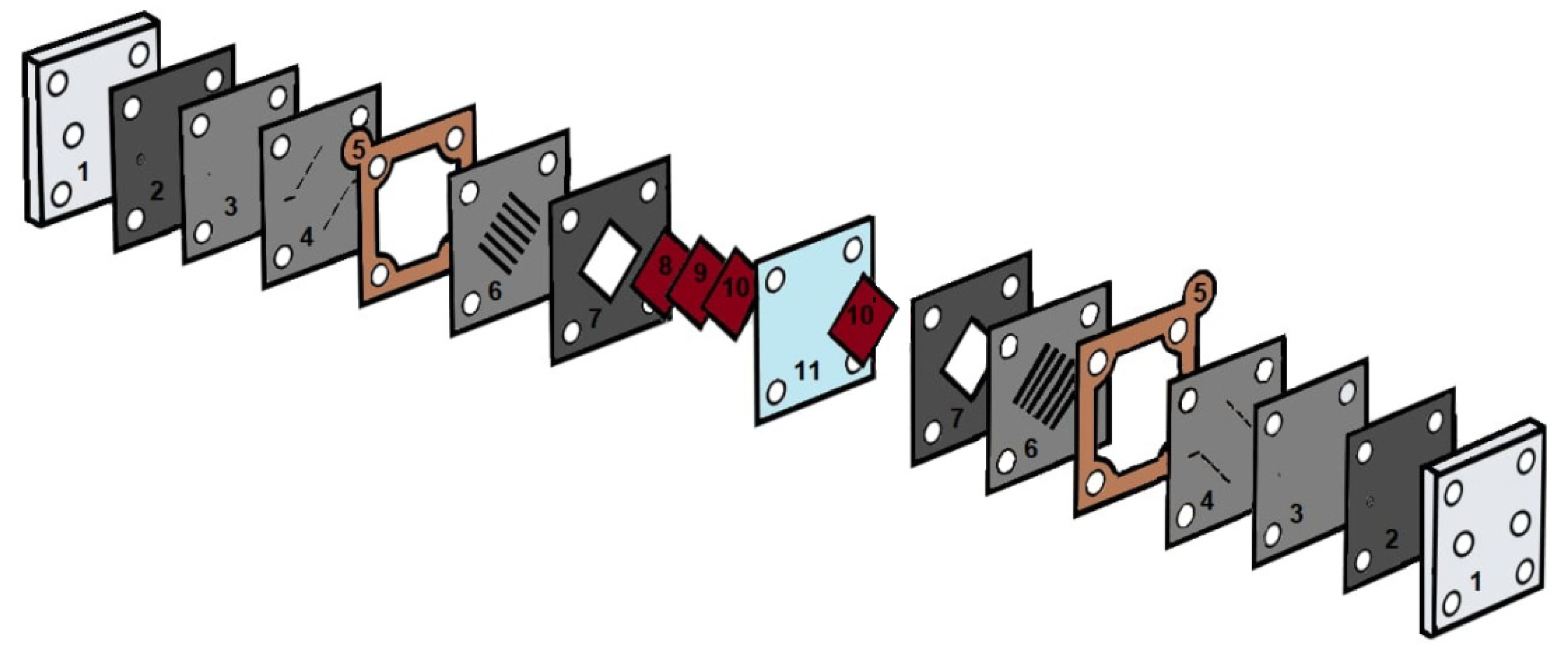
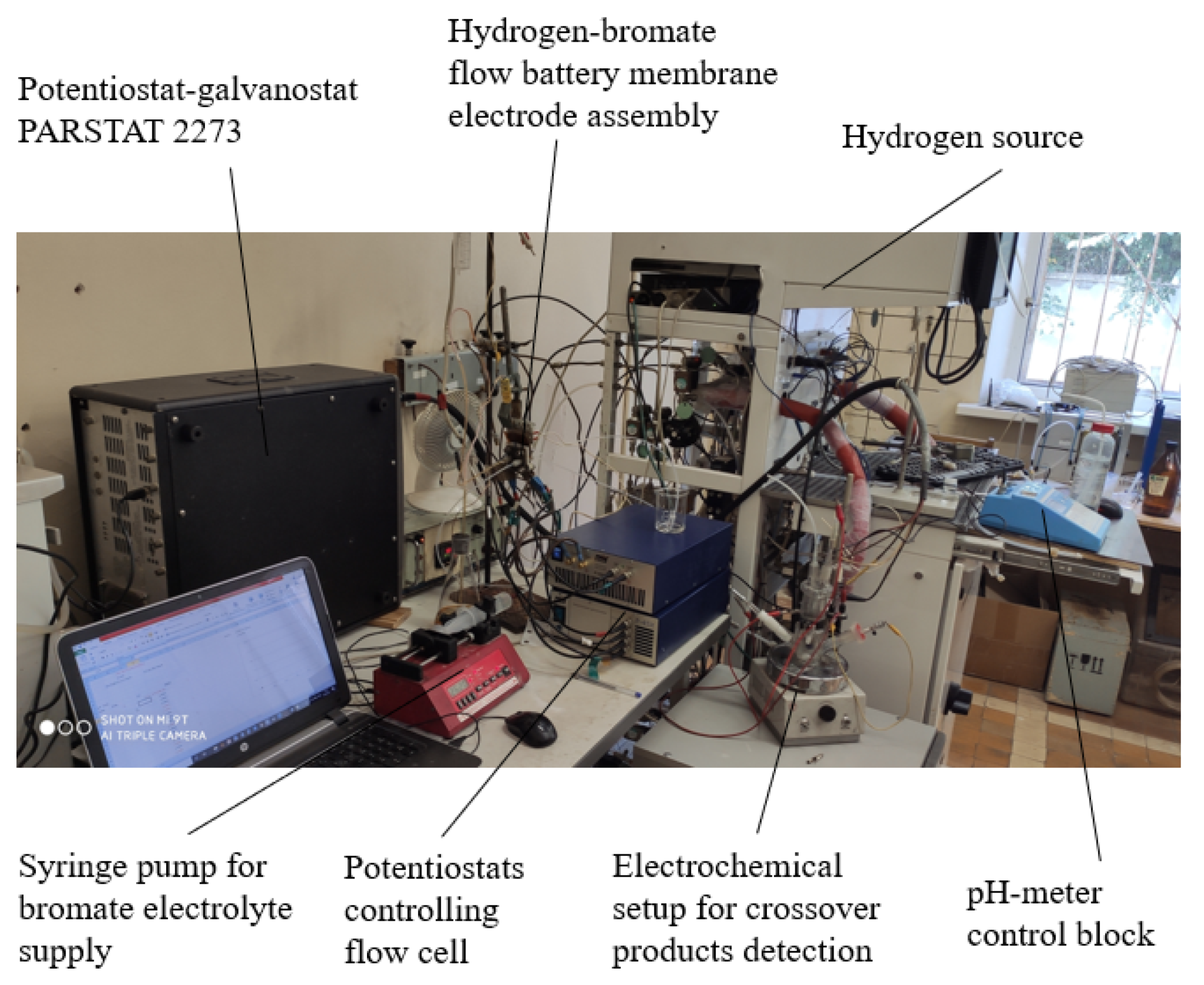

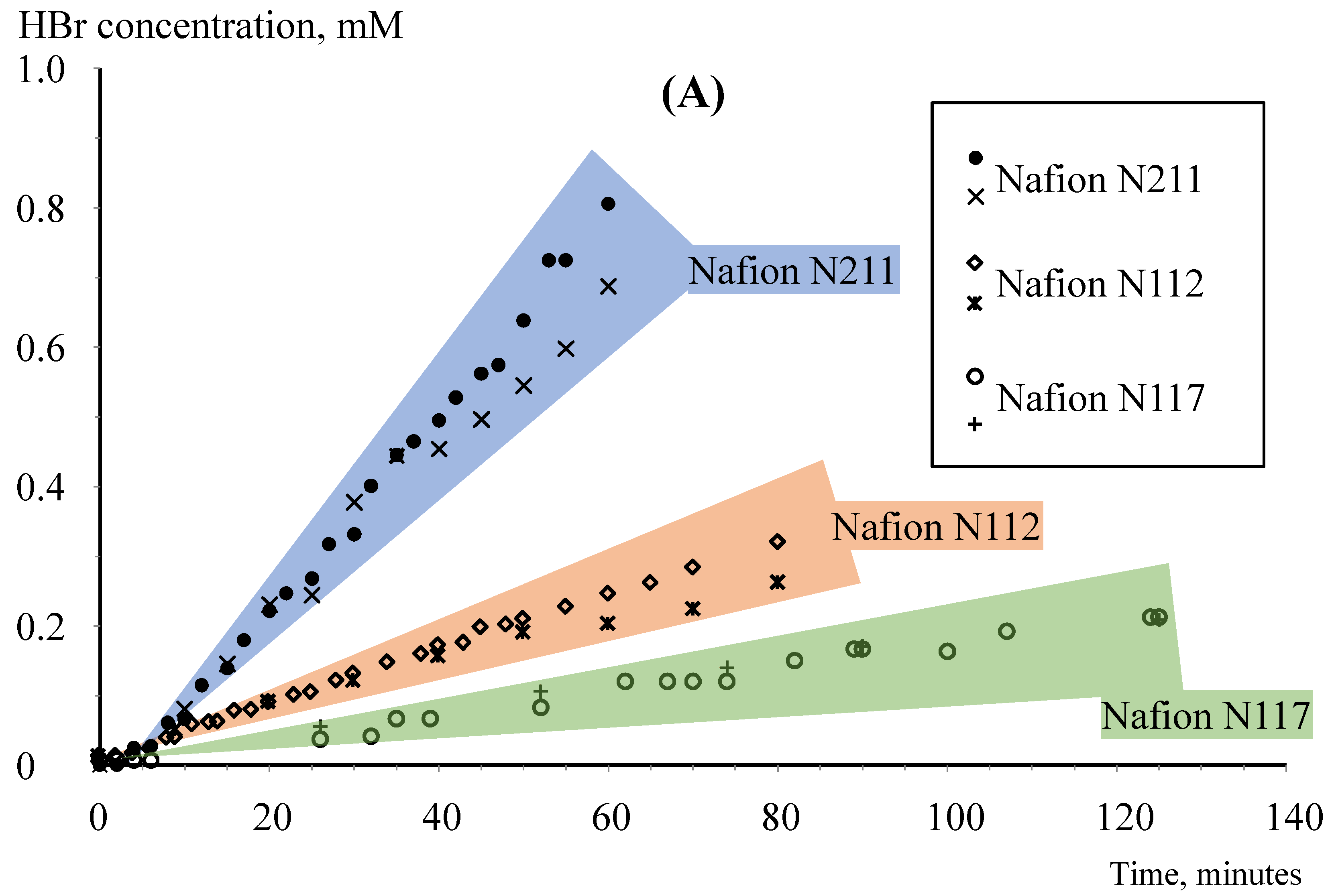

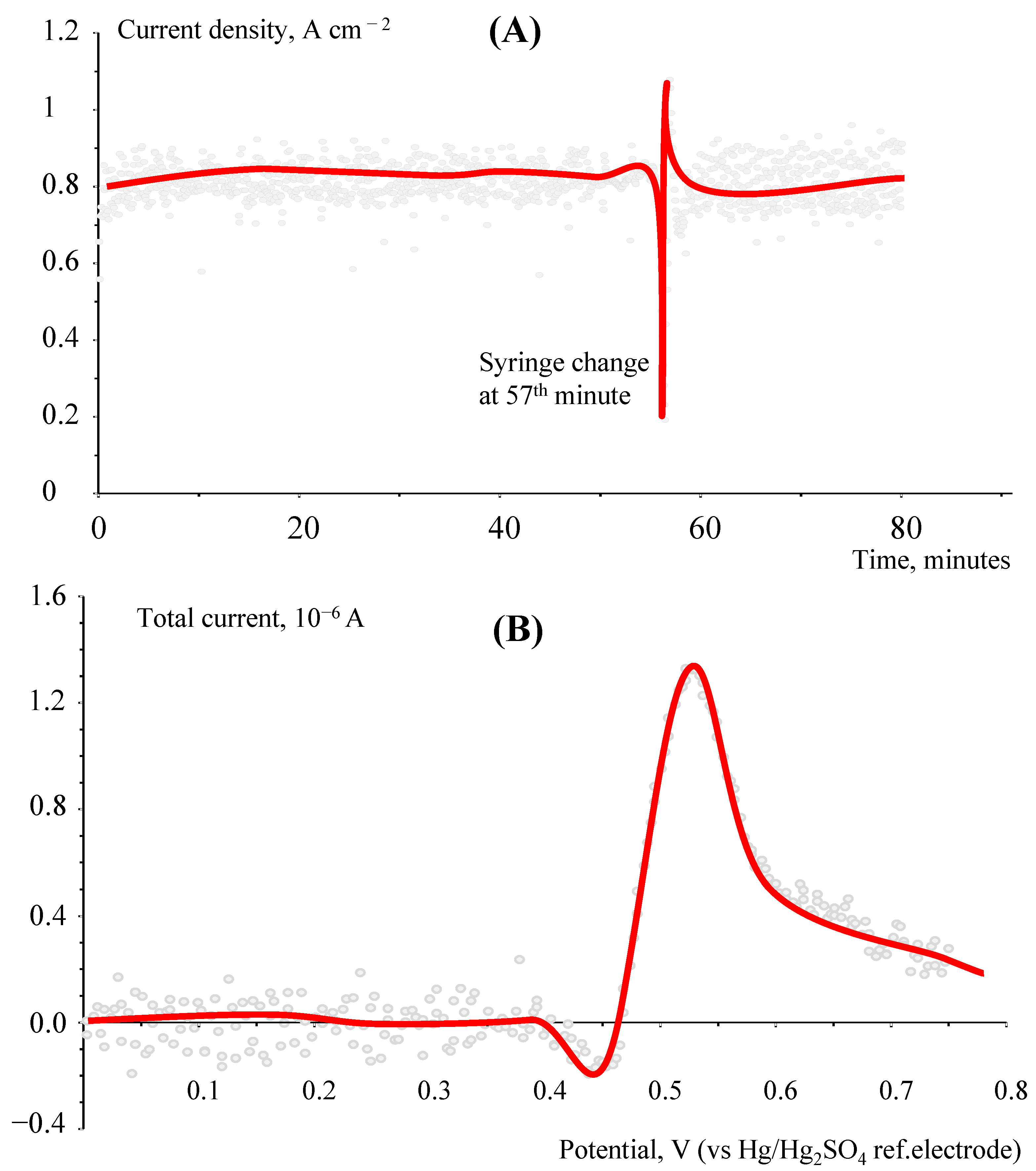

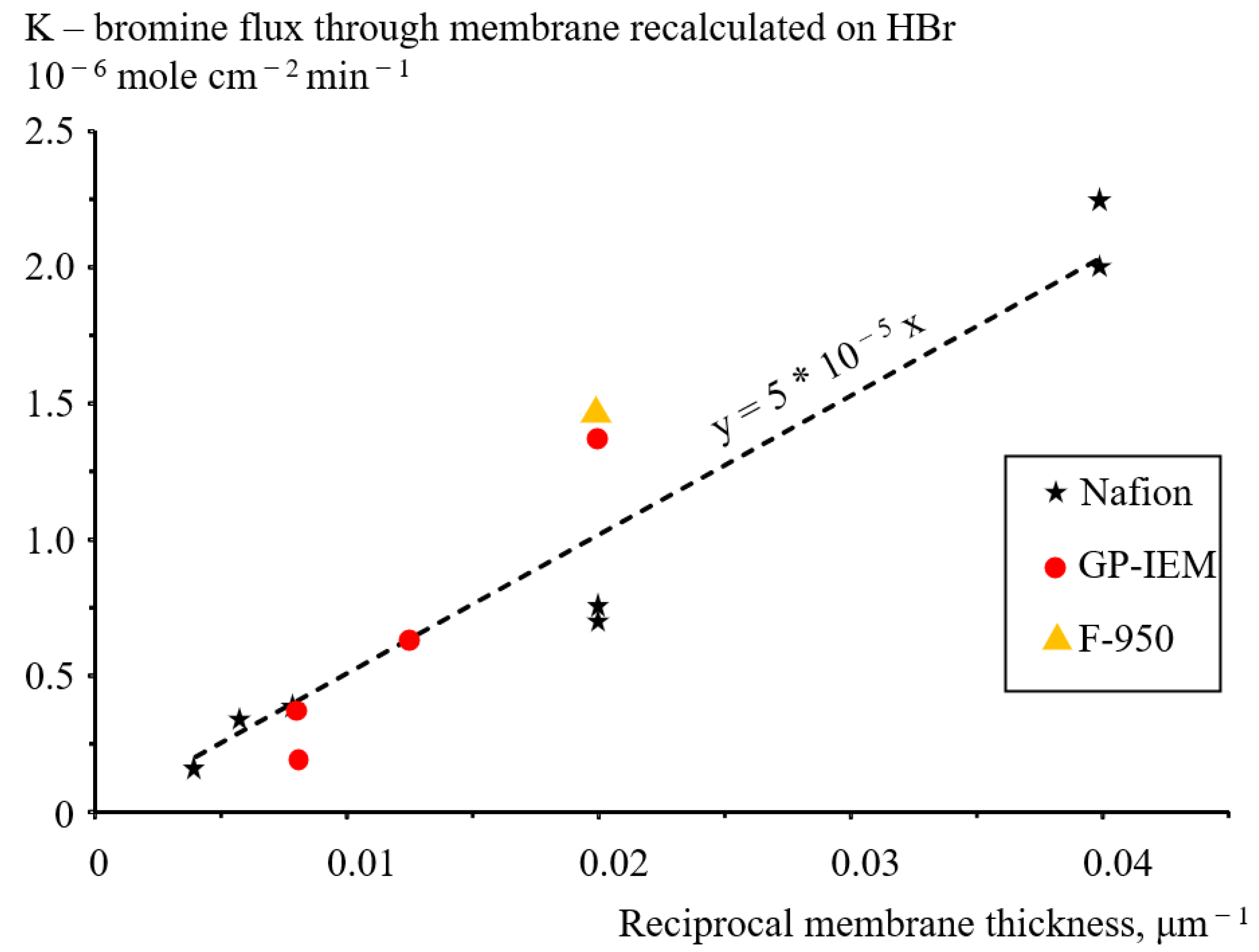
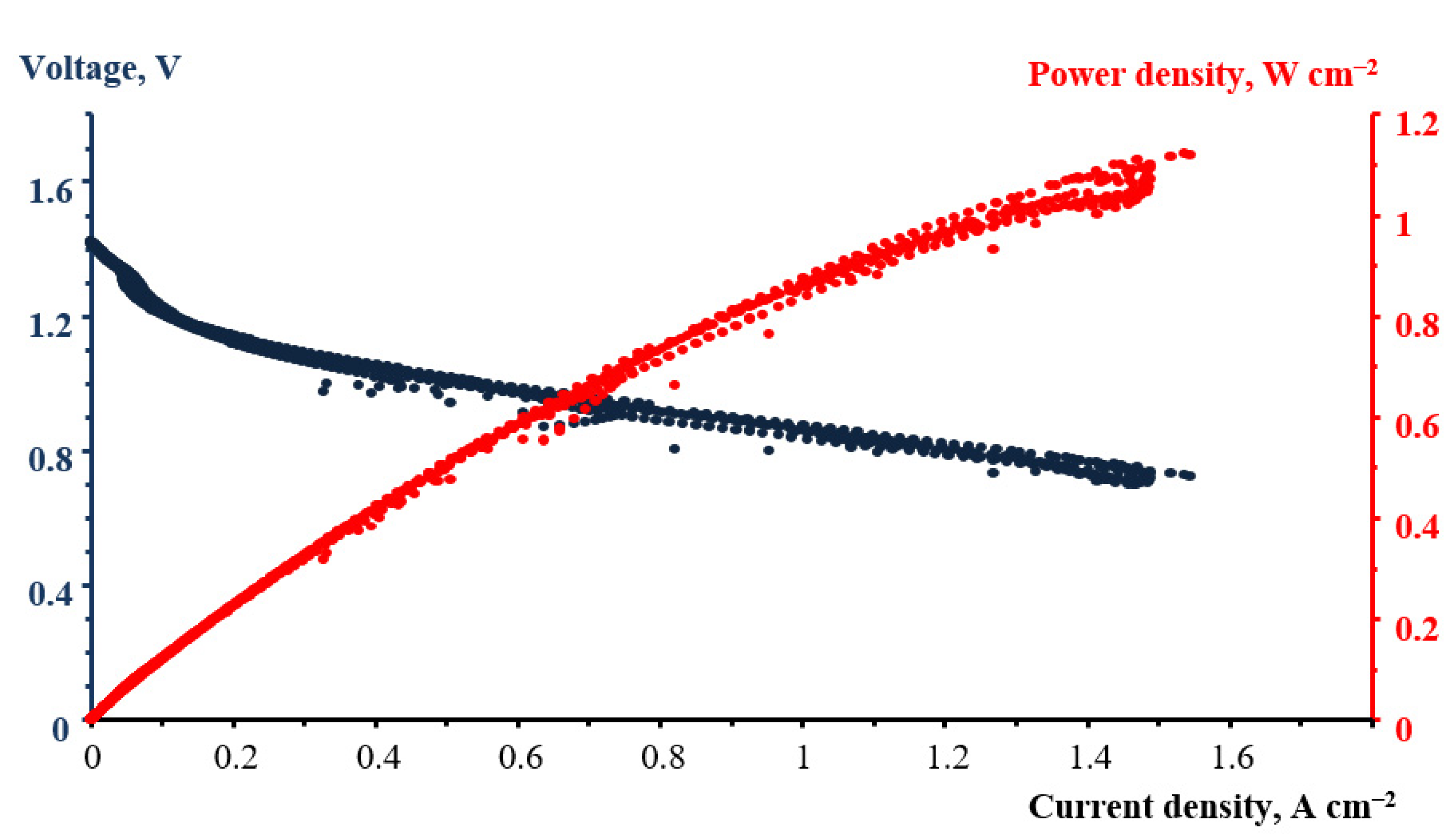
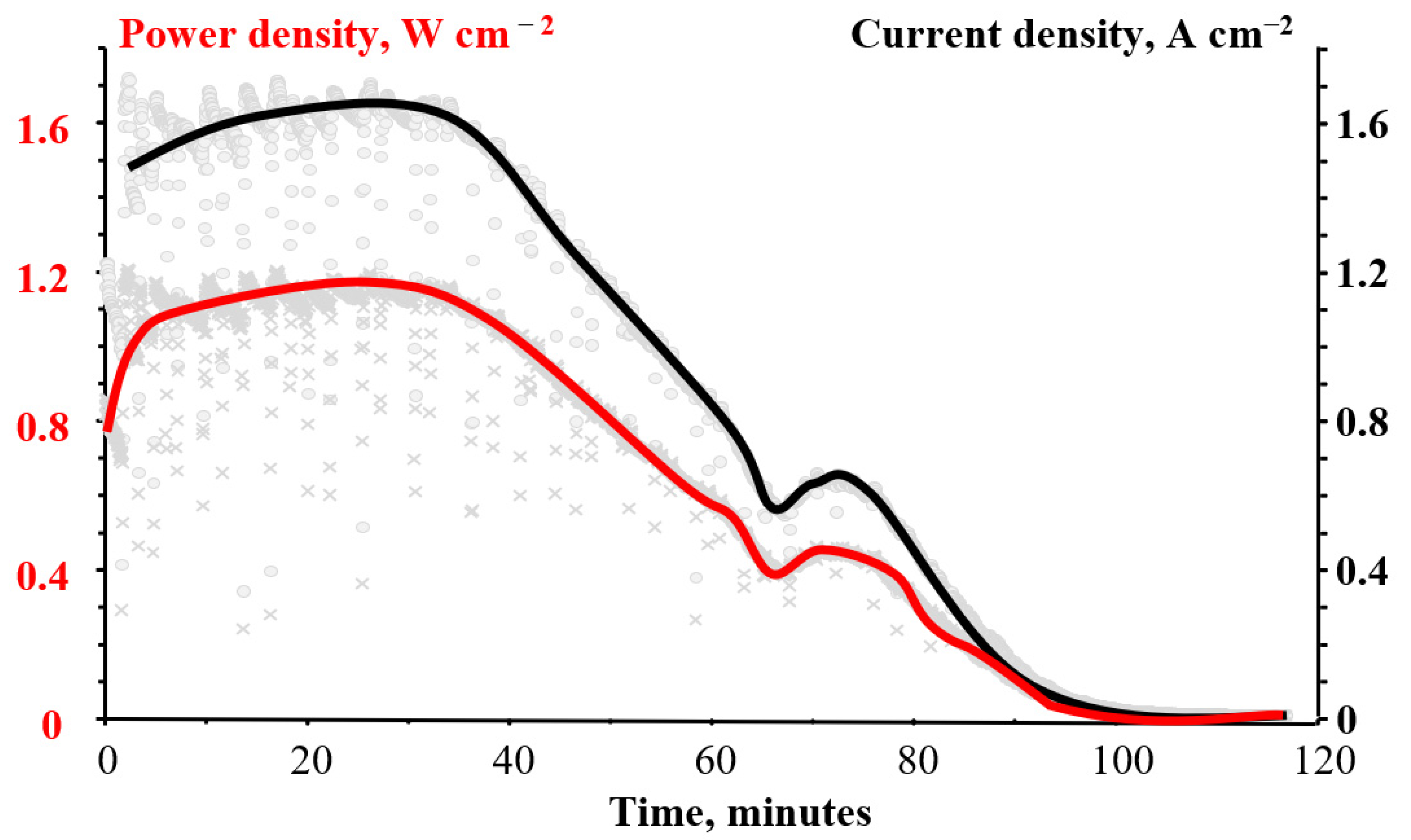
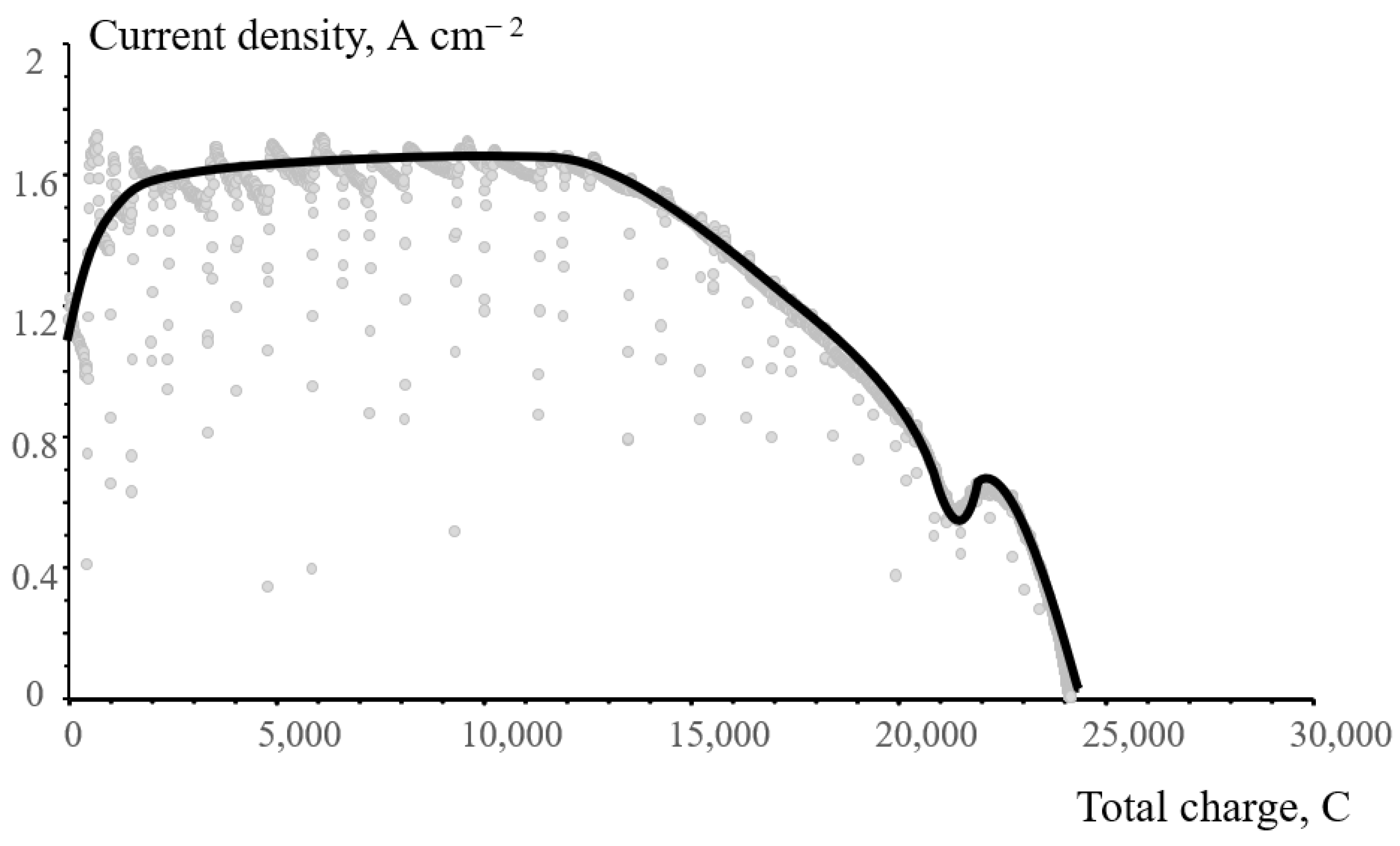
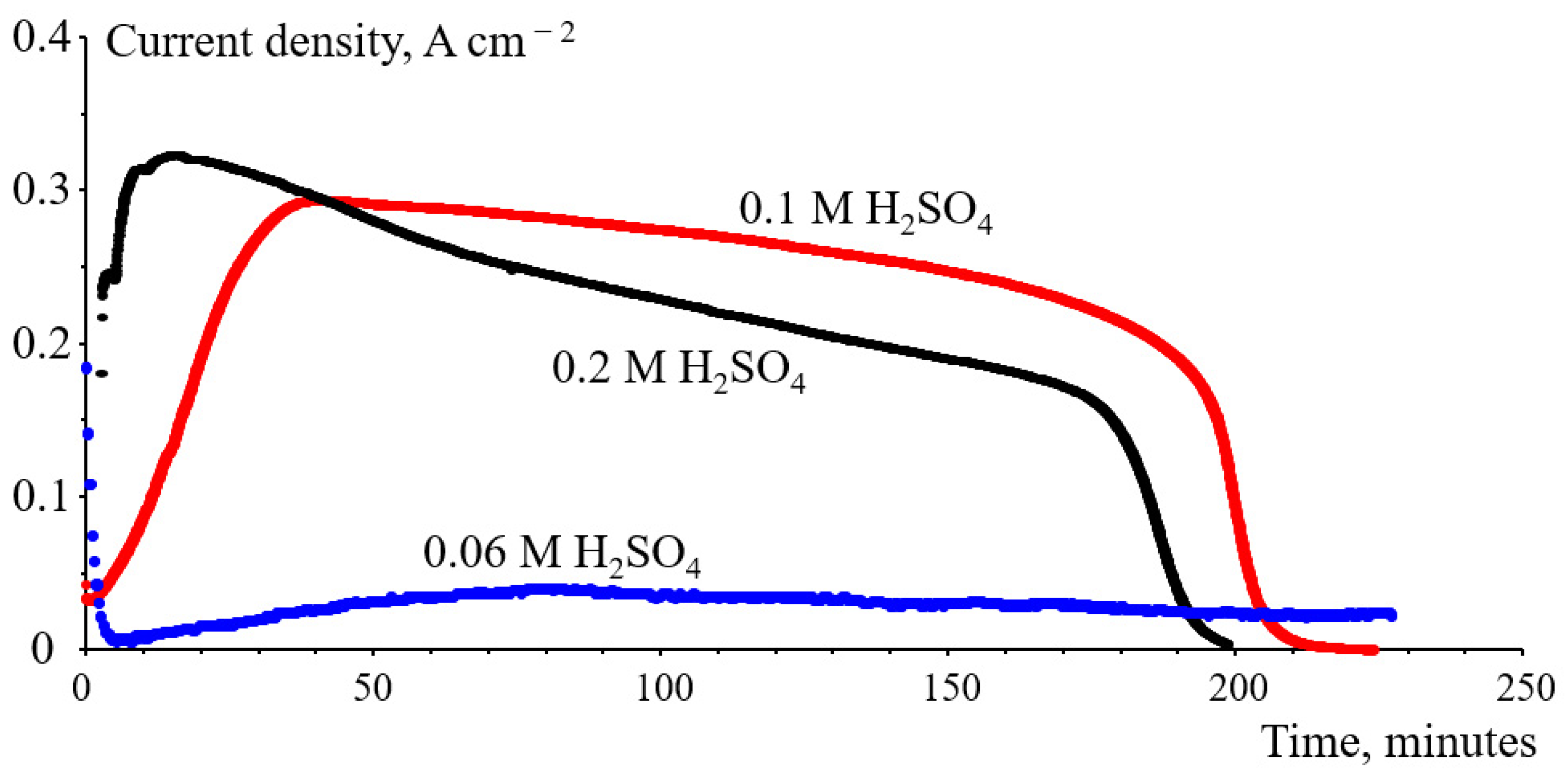
Publisher’s Note: MDPI stays neutral with regard to jurisdictional claims in published maps and institutional affiliations. |
© 2022 by the authors. Licensee MDPI, Basel, Switzerland. This article is an open access article distributed under the terms and conditions of the Creative Commons Attribution (CC BY) license (https://creativecommons.org/licenses/by/4.0/).
Share and Cite
Modestov, A.; Kartashova, N.; Pichugov, R.; Petrov, M.; Antipov, A.; Abunaeva, L. Bromine Crossover in Operando Analysis of Proton Exchange Membranes in Hydrogen−Bromate Flow Batteries. Membranes 2022, 12, 815. https://doi.org/10.3390/membranes12080815
Modestov A, Kartashova N, Pichugov R, Petrov M, Antipov A, Abunaeva L. Bromine Crossover in Operando Analysis of Proton Exchange Membranes in Hydrogen−Bromate Flow Batteries. Membranes. 2022; 12(8):815. https://doi.org/10.3390/membranes12080815
Chicago/Turabian StyleModestov, Alexander, Natalia Kartashova, Roman Pichugov, Mikhail Petrov, Anatoly Antipov, and Lilia Abunaeva. 2022. "Bromine Crossover in Operando Analysis of Proton Exchange Membranes in Hydrogen−Bromate Flow Batteries" Membranes 12, no. 8: 815. https://doi.org/10.3390/membranes12080815
APA StyleModestov, A., Kartashova, N., Pichugov, R., Petrov, M., Antipov, A., & Abunaeva, L. (2022). Bromine Crossover in Operando Analysis of Proton Exchange Membranes in Hydrogen−Bromate Flow Batteries. Membranes, 12(8), 815. https://doi.org/10.3390/membranes12080815







